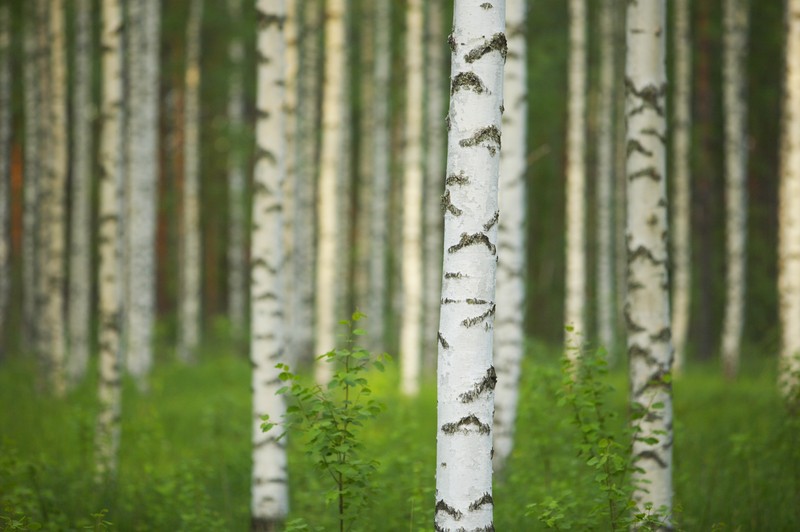The white birch is pretty much a Godsend when you need materials for lighting fires. But its usefulness isn't only limited to this one great feature. There are quite a few other uses for this excellent tree, as well, and you can check them out below.
White birch is easy to identify with its distinctive, white, papery bark. The sycamore tree also has white bark, but it does not sluff off in thin, paper-like furls like the white birch. The sycamore also has large hand-shaped leaves versus the white birch’s smaller, oval-shaped leaves with a pointed tip. The birch leaf is also irregularly toothed. These grow almost exclusively in northern climates.
White birch survival uses:
Sweet drinkable sap that does not need purification
Containers can be fashioned from the bark (and even canoes – hence the name “canoe birch”)
It’s papery bark makes some of the finest fire starting tender on the planet, which will light even when damp because of its resinous quality
A fine tea can be made from the small twigs at the end of a branch or by shaving the bark from new growth. Toss a palmful of these elements into boiling water for a fresh, wintergreen-flavored tea
The tinder fungus (chaga) grows almost exclusively on the white birch tree. The fungus is one of the only natural materials I know of that will take the spark from flint and steel. A piece of tinder fungus along with flint and pyrite to create sparks were even found on Otzi, the “iceman” who was uncovered in the Austrian Alps several years ago.
Pine tar can be extracted from the bark of the white birch by heating it over a fire. Pine tar makes an excellent natural adhesive which natives used for all kinds of purposes including securing stone points on arrows.
While not necessarily “pine tar”–the white birch isn't related to pine trees — the resin which can be extracted from the bark can indeed be used to make adhesive and it can also be concentrated to make lighting fires easier. The bark can be made into a drinking container, as well, due to its waterproofing abilities.
For collecting the drinkable sap, it's best to try the trick in the springtime, when the sap is flowing most freely. Go try some of these tricks today and you'll find yourself a happy camper!
This is a great lesson on an extremely useful tree. For more lessons like this, check out Willow Haven Outdoor.

Don’t forget Birch oil for your waterproofing oil lamp and liberation needs also.
Here’s more on The wonderful gift from God.
Nutritional Information and Properties
The sap from the birch tree contains vital vitamins, minerals, and sugars, mainly glucose and fructose. It is rich in minerals such as potassium, calcium, magnesium, manganese, zinc, phosphorous, iron, sodium, and amino acids. It is also rich in vitamin C and B-vitamins like thiamine. The sap from the birch tree is used to make syrup that you can consume directly or use as a part of salad dressings, soups, candies and even wine and beer. The buds of the birch tree contain antibiotic and diuretic properties while the bark contains digestive, diuretic, and anti-pyretic properties.
Health Benefits and Therapeutic Uses
Several health practitioners use the leaves and twigs of the birch tree for medicinal purposes. The leaves and twigs are often boiled to make anti-inflammatory treatments. Birch tree contains betulinic acid that gives it its anti-inflammatory properties, which are helpful in treating conditions like arthritis, high cholesterol, heart and kidney edema, and cystitis.
The medicinal properties of birch tree stimulate the digestive system and aid in better digestion. Its nutrients are also effective in strengthening the bones and boosting overall immunity. Experts usually recommend soaking birch tree leaves in apple cider vinegar for several weeks to help in the release of its minerals and micronutrients. You can consume this vinegar as a part of beverages and meals and drink it directly for treating coughs.
Birch tree contains strong astringent properties that make it an effective natural treatment for skin conditions like eczema, dermatitis, and furunculous. You can soak birch leaves in water for few hours and then use the strained solution for washing the skin as a treatment for these skin problems. It is also good for healing various other skin irritations.
A bath with birch leaf water is a good way to strengthen the hair roots and prevent problems like dandruff.
Birch leaves are commonly juiced and this juice is used for treating inflammations and infections of the urinary tract, edema, and renal calculosis. A decoction of birch tree buds helps increase urination and therefore helps in the treatment of edemas.
Birch tree contains powerful diuretic properties that help in flushing out harmful toxins, uric acid, and excess water from the body. This in turn helps in eliminating cellulite from the body and treats problems like obesity over time. It also helps in maintaining good kidney and liver health.
The buds of the birch tree are a rich source of vitamin C, tannin, and flavonoids, which makes them effective in the prevention of viral infections and even the formation of cancer.
http://www.home-remedies-for-you.com/herbs/birch-tree.html